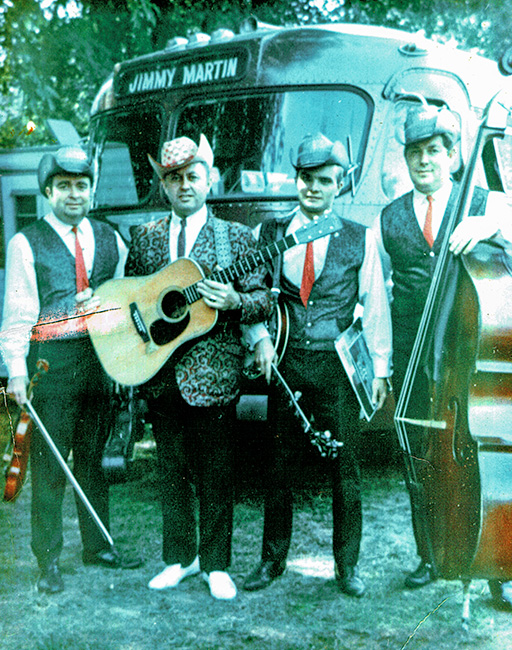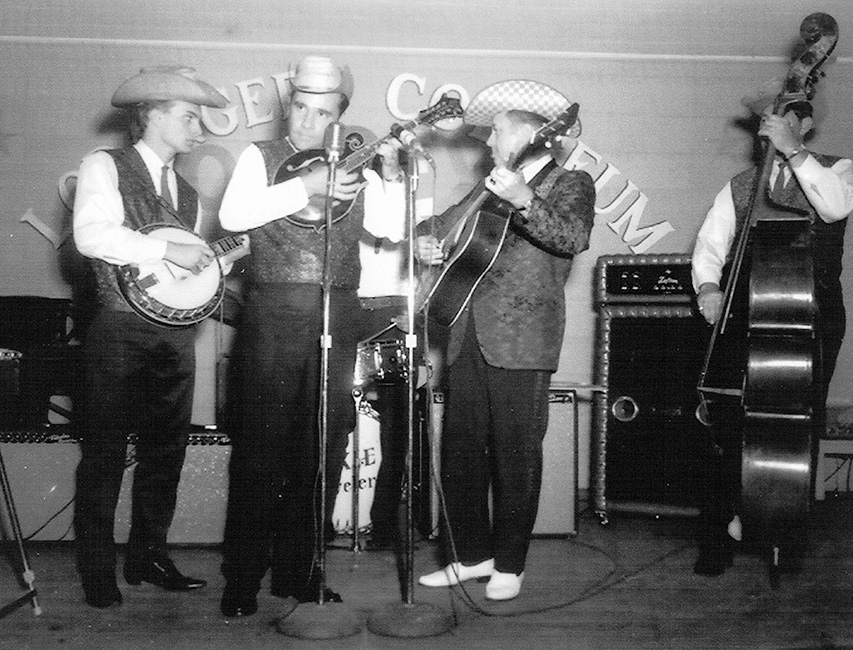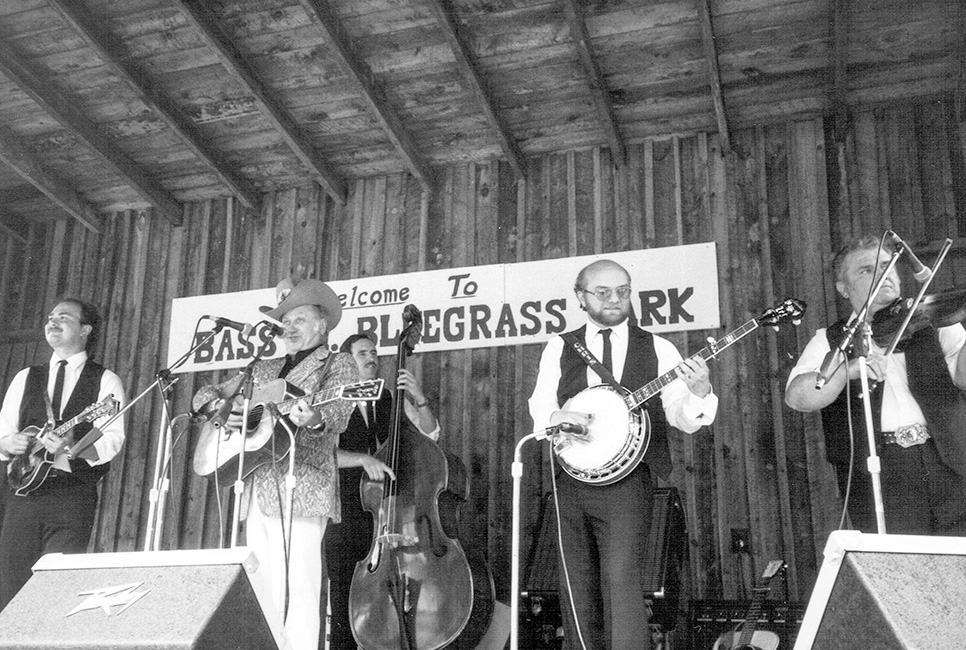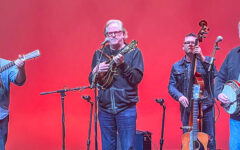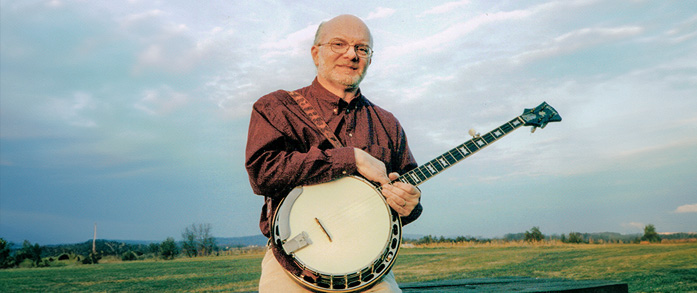
This recollection of Jimmy Martin’s lessons to his heralded banjo player Chris Warner is a contribution from Thomas Cook. Chris is widely regarded as one of the finest exemplars of the Jimmy Martin style on banjo, behind only J.D. Crowe and Bill Emerson. The photos are from Warner’s personal collection.
What made the first generation bluegrass music so powerful? Why does it still resonate 80 years after Earl Scruggs and Lester Flatt joined Bill Monroe’s Blue Grass Boys and musically tore down the Grand Ole Opry? What made these musicians and the music they created so great? It is too late for todays’ bluegrass musicians to go and hear Bill Monroe, Flatt & Scruggs, Reno & Smiley, The Stanley Brothers, and Jimmy Martin. But we can still learn from the musicians they fostered, such as the great banjo player, Chris Warner.
Chris, along with J.D. Crowe, Bill Emerson, Kenny Ingram, and others, was among Jimmy Martin’s definitional banjo players. Also an excellent mandolin player and baritone singer, he served two stints with the Sunny Mountains Boys (1967-’69 and again 1985-’89), and helped Jimmy Martin record some classic songs, including Freeborn Man, Milwaukee, Here I Come, Slowly, and Arab Bounce.
He also backed up or played for Del McCoury, Bill Monroe, Jim & Jesse, Rhonda Vincent, and Doyle Lawson, to name a few. Through it all he was listening and paying attention, and has some thoughts to impart to the younger generation of pickers and singers. Chris is serious about bluegrass, and he is of the opinion that there is fundamentally a right way and a wrong way to play the music. And he believes that what he learned from Jimmy Martin should be taken seriously by anyone who wants to play the music well, as opposed to simply thrashing at it.
Jimmy Martin is seen by many as a comic figure, given his brash stage presence and ebullient personality. While he certainly knew how to command the attention of his audience, he was very deliberate about his music, and set high standards for his band members. Knowing exactly what each vocal and instrumental part should sound like, each musician was expected to know his part and play it to Jimmy’s satisfaction under any circumstances. Hundreds of songs were recorded over a 50 year career, with a constantly rotating cast of musicians, yet his sound remained remarkably unchanged. He taught his Sunny Mountain Boys what he wanted, and those lessons are worth studying.
Jimmy was a fanatic about timing. He drilled his musicians to play the way he heard his music, and went so far as to forbid Sunny Mountain Boys to jam at a festival with lesser players because of the deleterious impact on their rhythm. As Chris Warner puts it, “When I went with Jimmy the first time from 1967 to 1969, I could play the notes that were on the records, but I couldn’t play them with his timing. That took a lot of work. Jimmy kept talking about timing, and I thought he meant meter. I was getting frustrated until Vassar Clements took me aside, and said in his understated way that, by timing, Jimmy meant meter, tone, bounce, syncopation, and dynamics.”
Chris refers to Jimmy’s timing as a shuffle, similar to the shuffle of a fiddle bow on a hoedown, which is much easier to demonstrate than to describe. This “one, two, and three” syncopated beat underlies all of Jimmy Martin’s music, both instrumental and vocal.
Jimmy Martin referred to the lack of dynamics in bluegrass rhythm as being like, “a dog trotting in dry leaves.” This is Jimmy’s slang for lesser singers and instrumentalists who perform with a sing-song quality to their music. Jimmy Martin insisted that the instruments play the way a great singer holds and slurs notes to create emotion. He believed that a great lead singer doesn’t sing in a monotone, or phrase his words mechanically.
This shuffle rhythm does not come naturally to many beginning players, but it can be learned. Chris says that he had to really work on not only the timing in his banjo playing, but learn to pronounce vowels the way Jimmy did for singing baritone, being from Pennsylvania rather than Tennessee. If you don’t pronounce words the same, says Chris, it is very difficult to get a good vocal blend.
“Open your mouth when you sing,” Jimmy would tell him. Chris relates that you have to extend your jaw out to achieve the “braying” vocal tone used by Jimmy, as well as Lester Flatt and Curly Seckler.
Chris points out that the great first generation bluegrass bands can be easily identified by their rhythm – the Stanley Brothers were very different from Flatt and Scruggs. Both are fine, in Chris’ opinion, just different. One of the things which created the Jimmy Martin sound was his exemplary rhythm guitar playing, which powered the Sunny Mountain Boys. Jimmy played on top of the beat with a syncopated double strum, plus runs.
Serious students of bluegrass music would do well to listen to Jimmy’s guitar playing on such songs as Foggy Old London, Chattanooga Dog, and Hold Whatcha Got, which create the pace and tone of the song. Many contemporary guitar players are followers of Tony Rice and Clarence White, without realizing that both were excellent, solid rhythm players in addition to their lead work. Both admired Jimmy’s guitar playing. Chris says that guitar players in a band context should focus on the rhythm; the cake being more important than the frosting.
Chris points to the recorded version of Sunny Side of the Mountain as a good example of the classic Jimmy Martin style. The kickoff is a syncopated triplet – counted “trip-o-let-four-and” – which is economical, driving, and exact. During the break, Vernon Derrick plays the melody with double stops; at the end of the lines he executes a classic signature motif; he uses an upstroke of the pick over four strings to create syncopation and rhythm.
Another classic is the Paul Williams’ mandolin treatment on Drink Up and Go Home. Listen to how Paul lingers over the notes the way a singer would. It frames the melody with elegant punctuation and ornamentation, which complements rather than overwhelms the song. It’s a perfect set up for Jimmy, one of the great vocalists of bluegrass music, to tell the story.
Chris credits Jimmy Martin with teaching him how to play his style of backup on the banjo as well. Jimmy has, with occasional exceptions, two basic rules for backup: 1. Don’t play the same notes that the person at the mic is hitting. When the melody goes down, you go up. 2. Keep it simple; “don’t detract from what the lead vocal is doing. Your job on back up is to make the singer or picker sound good.”
He also believed that the first three or four notes of a lead instrumental break are important and should “pop” or “bounce.” They should be distinctly emphasized. Jimmy wanted his players to lead up to the melody note and really hit it, and then back off creating dynamic tension and resulting interest for the listener. J.D. Crowe learned this so well because Jimmy spent more time teaching J.D. than any other banjo player he had, and perhaps because Crowe was so young when he entered The Sunny Mountain Boys.
Musicians who insert too many fancy licks and run excessive scales risk tiring the listener and losing the narrative thread of the song. Playing the melody during a break reinforces the song because, in Jimmy’s view, too much improvisation was aimless noodling, and was to be avoided. Jimmy and Hershel Sizemore used to fight over this; later in life Herschel admitted that he should, in retrospect, have done it Jimmy’s way.
Sizemore was, of course, one of the great mandolin players in bluegrass, and had excellent technique. Many lesser players attempt fancy playing but haven’t done their homework. Jimmy Martin’s credo was, “listen to the record, learn the music, practice and be able to play it with drive, taste, and dynamics.”
Chris points to Earl Scruggs. “Earl wasn’t a fancy player. He was a strong musician with great taste, power, timing, and dynamics.” Chris notes that Jimmy Martin loved the singing and playing of Paul Williams. Paul always played exactly the right lick in the right spot on his mandolin. His playing is deceptively simple, yet careful listening reveals that Paul, like Earl, played with taste, tone, and touch due in part to Jimmy’s coaching.
In Jimmy’s view, a solo, like a letter, should have a salutation or beginning, contain full sentences which say something meaningful, have appropriate punctuation, and an ending which summarizes and completes the statement. The instrumental break, like the lead singing, should convey meaning and emotion, although he couldn’t articulate it in quite that way. Chris quotes Jimmy as telling him to just, “play it pretty.”
Jimmy made exceptions for hot players who “had what it takes,” meaning that they understood melody and dynamics and could bring something new to the Sunny Mountain Boys. A good example is the nice mandolin style of Vernon Derrick who played mandolin with Jimmy, and pedal steel with Kitty Wells, before a long stint on fiddle with Hank Williams, Jr. Vernon loved the music of Chuck Berry and worked on converting Berry’s guitar licks to the mandolin, and delivering them on stage with some real moves. See Jimmy Martin & the Sunny Mountain Boys with Vernon Derrick and Alan Munde play Tennessee on the Del Reeves Show. Jimmy let him do it because Vernon could instrumentally pull it off, and could really sell it to an audience.
Jimmy Martin’s music wasn’t easy to play, but it was simple in structure. Jimmy didn’t want things cluttered; he wanted to emphasize the melody. A few hot licks were OK if they fit the song, but his musicians had to remember they were playing for an audience who were there to hear Jimmy’s music.
Chris says it may sound like a paradox, but that it is a challenge to play simple music well. One key is constant practice. Chris quotes Jimmy as saying, “learn your break! Listen to the records!” That way, a musician could perform to a high level no matter what the conditions. Chris notes that the really good players – citing J.D. Crowe and Doyle Lawson – never overplay. They know exactly the volume they should perform at, and never vary it, no matter how deficient the sound system might be. Overplaying leads to choppy rhythm, bad tone, and missed notes. Lesser musicians beat on their instruments – “thrashing” in Jimmy’s slang – meaning volume at the expense of finesse.
What would Chris say to aspiring bluegrass musicians who want to play in a way that Jimmy Martin or Earl Scruggs would approve of? Chris notes that he is discussing the music of Jimmy Martin and that the following tips are fundamental rules of thumb. Different styles call for different approaches; fancy playing is OK if the style of music calls for it, and it is played with the aforementioned drive, punch and dynamics
1. Keep your pick(s) moving, put rhythm to it. At the end of a phrase, put in a little bit of extra something. Give it a little syncopation without losing the melody. It should be exciting and not mechanical. You can use off-time licks tags as long as you keep the overall timing.
2. Learn the melody of every song you play, and don’t lose sight of it! Don’t show off with lots of fancy licks unless the style of bluegrass calls for fancier playing. Remember that you are playing for an audience, and don’t play to impress other musicians by showing what you know. Audiences like melodies. Also, that fancy lick that you can do in your living room may not be so easy to play live. Practice your break until it is fixed in your brain and the notes are clean.
3. Every note should be distinct. Go for tone and play pretty. Don’t noodle, go for clarity. Every break or kickoff should tell a story with a beginning, middle, and end. Every break should begin with a bouncy pop leading up to the main note, maybe with a slide or double stop to emphasize it. Then, lighten up.
Play the melody, choosing the notes you want to emphasize. Build the solo like a singer would. Play consistently with dynamics and emotion. End with a flourish. If you are playing two breaks, play simply the first time and fancier the second, if you can do it without losing timing and tone.
4. Play with dynamics. Every note shouldn’t be played at the same volume. Build to a crescendo with solid, well-executed notes. Create an ebb and flow. Slide or hammer into important notes like a singer would. Create off-time runs with hammer-ons, pull-offs, and varied right hand patterns.
If you are interested in hearing Chris demonstrate his precepts; give a listen to his CD, Goin’ To the Dance, on Patuxent records. It is a Master Class on bluegrass timing from a bluegrass master who really knows his subject.
Goodness gracious, it’s good.


